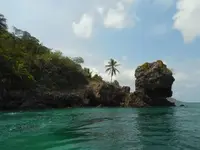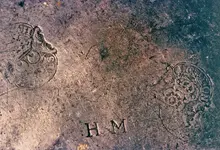You are using an out of date browser. It may not display this or other websites correctly.
You should upgrade or use an alternative browser.
You should upgrade or use an alternative browser.
Buried Pirate Treasure in Panama
Colombiapictures
Hero Member
BillA
Bronze Member
no indication Morgan had anything to bury
KANACKI
Bronze Member
- Joined
- Mar 1, 2015
- Messages
- 1,445
- Reaction score
- 5,940
- Golden Thread
- 0
- Primary Interest:
- All Treasure Hunting
Alexandre Exquemelin may have indeed had a gripe against Morgan. As it was true many of buccaneers was left behind to fend for themselves at Porto bello. What history forgets Morgan was not acting as pirate in eyes of British. Although it is true he violated the terms of his old letter of Marque as Privateer as he was only licence to capture Spanish Shipping not Spanish Towns. And of course regardless To the Spanish he will always be seen rightly so in their eyes a pirate. However Morgan campaign was a privateering operation in which he was in effect controlling an unruly mob of pirates.
He shows he was acting as privateer when he stopped a group breaking off and sailing on pirating operations along the coast. He kept his rabble army from descending in a huge free for all fight among themselves. Knowing he could never hold Panama and the city itself was in ruins. Nor could he hold Porto Bello. So naturally he retreated to his rear guard stationed at Porto Bello and divided money among the surviving Buccaneers. The each got about 200 pieces of eight but you have take in account there was at least 1200 surviving Buccaneers . In 1670 50 silver pieces of 8 was a small fortune to have 200 was a fortune. Morgans share was 1200 as commander.
Where the resentment took place because Alexandre Exquemelin was left behind to fend for himself. What Alexandre Exquemelin forgets Morgan acting on behalf of his original letter of Marque 50% of spoils belonged to the English Crown. If Morgan had thought he acted as a pirate he would of never returned to England like he did. Fact he was never arrested for piracy speaks volumes where 50% dare say the undecidable plate gold and silver ended up. That is why claims in Alexandre Exquemelin's book did not hold up in English courts and Morgan won a libel action against the publishers.
While it must of been difficult for the English Crown in dealing with Spanish Crown at the time. On one hand if English Crown never got a cut from the raid they could of simply complied with Spain's request to try Morgan as a pirate? However if that was so they may had to admit liability and pay compensation. And hand back their 50% share back to Spain. So it was a better for the English crown to say nothing publicly about their 50% and go with English Public opinion at the time that Morgan was privateer and a hero.
As for claims of Morgan being brutal in truth it was no different with many rulers or people living in that time period.
Kanacki
He shows he was acting as privateer when he stopped a group breaking off and sailing on pirating operations along the coast. He kept his rabble army from descending in a huge free for all fight among themselves. Knowing he could never hold Panama and the city itself was in ruins. Nor could he hold Porto Bello. So naturally he retreated to his rear guard stationed at Porto Bello and divided money among the surviving Buccaneers. The each got about 200 pieces of eight but you have take in account there was at least 1200 surviving Buccaneers . In 1670 50 silver pieces of 8 was a small fortune to have 200 was a fortune. Morgans share was 1200 as commander.
Where the resentment took place because Alexandre Exquemelin was left behind to fend for himself. What Alexandre Exquemelin forgets Morgan acting on behalf of his original letter of Marque 50% of spoils belonged to the English Crown. If Morgan had thought he acted as a pirate he would of never returned to England like he did. Fact he was never arrested for piracy speaks volumes where 50% dare say the undecidable plate gold and silver ended up. That is why claims in Alexandre Exquemelin's book did not hold up in English courts and Morgan won a libel action against the publishers.
While it must of been difficult for the English Crown in dealing with Spanish Crown at the time. On one hand if English Crown never got a cut from the raid they could of simply complied with Spain's request to try Morgan as a pirate? However if that was so they may had to admit liability and pay compensation. And hand back their 50% share back to Spain. So it was a better for the English crown to say nothing publicly about their 50% and go with English Public opinion at the time that Morgan was privateer and a hero.
As for claims of Morgan being brutal in truth it was no different with many rulers or people living in that time period.
Kanacki
KANACKI
Bronze Member
- Joined
- Mar 1, 2015
- Messages
- 1,445
- Reaction score
- 5,940
- Golden Thread
- 0
- Primary Interest:
- All Treasure Hunting
While indeed their is a fine line between being a Privateer and being an outright pirate. In Henry Morgans day in English Eyes he was a Successful Privateer. Of course to Spanish and the mostly french and other rag tag pirate left behind to fend for themselves in Porto Bello like Alexandre Exquemelin he was a pirate. Later authors have glamorized Henry Morgan into a great pirate chief as we see in popular Media today.
Kanacki
Kanacki
KANACKI
Bronze Member
- Joined
- Mar 1, 2015
- Messages
- 1,445
- Reaction score
- 5,940
- Golden Thread
- 0
- Primary Interest:
- All Treasure Hunting
Now its true to say Henry Morgan became a legendary pirate of folk lore. In the middle of the last part of 1920's decade claims sprang up in regards so called alleged descendants claiming to have knowledge of treasure hidden by Henry Morgan?
In 1927 there was an alleged discovery under the ruined church of San Jose in the old neglected ruins of old Panama. That created interest through newspapers all over the world. You can see the story below.....In the San Jose News dated 12 August 1927
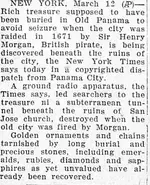
I have more to show on that story but patience my friends. I am on island time.
Kanacki
In 1927 there was an alleged discovery under the ruined church of San Jose in the old neglected ruins of old Panama. That created interest through newspapers all over the world. You can see the story below.....In the San Jose News dated 12 August 1927

I have more to show on that story but patience my friends. I am on island time.
Kanacki
KANACKI
Bronze Member
- Joined
- Mar 1, 2015
- Messages
- 1,445
- Reaction score
- 5,940
- Golden Thread
- 0
- Primary Interest:
- All Treasure Hunting
In 1928 stories of two rival alleged descendants made claims in several newspaper stories like the one below. Manchester chronicle 1928
PIRATE GOLD.
MORGAN'S*BURIED*WEALTH
Gold is the prize of a thrilling treasure hunt which is now in progress,with two descendants of Sir*Henry
Morgan,*the famous buccaneer, as rivals. The*treasure*is the booty believed to have been*buried*by the pirate after the historic sack of Panama City. Millions of pounds in gold' bars and Jewels ore said to lie hidden.
A search in England for*Morgan's lost charts by Mr. Donald*Morgan,*one of the pirate's descendants, lies behind one of the*treasure*hunts. His search completed, Mr.*Morgan*had just left London on his way to Naples when he learnt that another descendant, a Louis*Morgan,*of Texas, had set Out from San Francisco, intent on discovering the hoard.
In an interview, Mr.*Morgan*stated that the plans of his party were to leave Providence (U.S.A.), pick uptwo companions at St. Georges (Bermuda), and proceed via the Panama Canal to the west coast. They hoped to be on the job first.
"I have spent two months In England and Wales searching for data for our research," he added. "At Lynmouth (Devon), one of the last ports the pirates touched, and where subsequently settled a number of his mariners, I came into possession of the chart used by the ill-fated expedition of 1856-with the same purpose as ours in view.
"I have mode a copy, but place no confidence in the chart. But I have"another chart in which I place more confidence."It was dictated from memory by an old seaman's wife at Lynmouth, who remembered having heard the story as passed from mouth to mouth
in her family, back to one of mariner ancestors in the 17th century.
"It is my theory, substantiated by this chart, that the*treasure*is not buried,*according to tradition, on a bayou, but on a certain rocky promontory near Darien Bay."
WHEN PANAMA WAS SACKED.
When the two great-nephews of Sir Henry*Morgan*emigrated to America shortly before the Revolution the one brother settled in Carolina. According to Mr. Donald*Morgan,*he and his brother are the only remaining descendants of this branch.
"It may be," he said, "that Louis Morgan.*of Texas, is a descendant of the other brother." Morgan's*capture of Panama is one
of the most extraordinary exploits on record.
Kanacki
PIRATE GOLD.
MORGAN'S*BURIED*WEALTH
Gold is the prize of a thrilling treasure hunt which is now in progress,with two descendants of Sir*Henry
Morgan,*the famous buccaneer, as rivals. The*treasure*is the booty believed to have been*buried*by the pirate after the historic sack of Panama City. Millions of pounds in gold' bars and Jewels ore said to lie hidden.
A search in England for*Morgan's lost charts by Mr. Donald*Morgan,*one of the pirate's descendants, lies behind one of the*treasure*hunts. His search completed, Mr.*Morgan*had just left London on his way to Naples when he learnt that another descendant, a Louis*Morgan,*of Texas, had set Out from San Francisco, intent on discovering the hoard.
In an interview, Mr.*Morgan*stated that the plans of his party were to leave Providence (U.S.A.), pick uptwo companions at St. Georges (Bermuda), and proceed via the Panama Canal to the west coast. They hoped to be on the job first.
"I have spent two months In England and Wales searching for data for our research," he added. "At Lynmouth (Devon), one of the last ports the pirates touched, and where subsequently settled a number of his mariners, I came into possession of the chart used by the ill-fated expedition of 1856-with the same purpose as ours in view.
"I have mode a copy, but place no confidence in the chart. But I have"another chart in which I place more confidence."It was dictated from memory by an old seaman's wife at Lynmouth, who remembered having heard the story as passed from mouth to mouth
in her family, back to one of mariner ancestors in the 17th century.
"It is my theory, substantiated by this chart, that the*treasure*is not buried,*according to tradition, on a bayou, but on a certain rocky promontory near Darien Bay."
WHEN PANAMA WAS SACKED.
When the two great-nephews of Sir Henry*Morgan*emigrated to America shortly before the Revolution the one brother settled in Carolina. According to Mr. Donald*Morgan,*he and his brother are the only remaining descendants of this branch.
"It may be," he said, "that Louis Morgan.*of Texas, is a descendant of the other brother." Morgan's*capture of Panama is one
of the most extraordinary exploits on record.
Kanacki
KANACKI
Bronze Member
- Joined
- Mar 1, 2015
- Messages
- 1,445
- Reaction score
- 5,940
- Golden Thread
- 0
- Primary Interest:
- All Treasure Hunting
Here is post of Louis Morgan. One of the problems of 20th century newspapers they are prone exaggerate and more tabloid in nature? One thing in several versions of Louis Morgan is reporters mixed up the gender. Some newspaper stories report Louis Morgan as a male while other report Louis Morgan as a female.
Here is a version of one story below.
Seeks Hidden Gold of Pirate Ancestor
Girl Descendant of Sir Henry Morgan Finds Old Map of Treasure Trove.
Echoes of stirring tales of the freebooters on the Spanish Main. A fair descendant of the famous pirate of 250 years ago. Sir Henry Morgan, is to lead an expedition in quest of sunken treasure.
The lost treasure of gold plate, bullion, and rare jewels, perhaps worth a million dollars, lies hidden under less than sixty feet of water in a little secluded bay somewhere in the West Indies.
A map traced with red fluid – perhaps blood – outlines the position of this little bay and tells the precise location of the treasure.
This map came into the possession of Virginia Morgan, a direct descendant of the pirate’s family, a few years ago. Now this pretty girl who hails from North Carolina, plans to head her own expedition to recover the long lost treasure of gold and gems.
Three Columbia University students and a New York lawyer are taking care of the details of the venture for Miss Morgan and two girl friends who are in on the secret plan to go on the expedition.
As for the history of the million dollar treasure: It was the year 1671, Henry Morgan was the commander of several vessels and about 1,300 troops in the famous raid upon Panama. During the attack on the capital city a galleon loaded with gold plate and jewels and manned by several survivors of the city set sail under cover of the darkness.
Kanacki
Here is a version of one story below.
Seeks Hidden Gold of Pirate Ancestor
Girl Descendant of Sir Henry Morgan Finds Old Map of Treasure Trove.
Echoes of stirring tales of the freebooters on the Spanish Main. A fair descendant of the famous pirate of 250 years ago. Sir Henry Morgan, is to lead an expedition in quest of sunken treasure.
The lost treasure of gold plate, bullion, and rare jewels, perhaps worth a million dollars, lies hidden under less than sixty feet of water in a little secluded bay somewhere in the West Indies.
A map traced with red fluid – perhaps blood – outlines the position of this little bay and tells the precise location of the treasure.
This map came into the possession of Virginia Morgan, a direct descendant of the pirate’s family, a few years ago. Now this pretty girl who hails from North Carolina, plans to head her own expedition to recover the long lost treasure of gold and gems.
Three Columbia University students and a New York lawyer are taking care of the details of the venture for Miss Morgan and two girl friends who are in on the secret plan to go on the expedition.
As for the history of the million dollar treasure: It was the year 1671, Henry Morgan was the commander of several vessels and about 1,300 troops in the famous raid upon Panama. During the attack on the capital city a galleon loaded with gold plate and jewels and manned by several survivors of the city set sail under cover of the darkness.
Kanacki
KANACKI
Bronze Member
- Joined
- Mar 1, 2015
- Messages
- 1,445
- Reaction score
- 5,940
- Golden Thread
- 0
- Primary Interest:
- All Treasure Hunting
Lieutenant George Williams Former Britsh Naval officer made a deal with the Panamanian Government. 75% on any treasure found went to the Government and 25% to Williams. Williams with a primitive metal detector in 1928 found items in several places mostly silver places etc... As well as old Panama another place called Chame about 40 miles north of old Panama. He also made a discovery of some treasure in ruins of the church at Porto Bello. Allegedly the Spanish commander thought to the death at the time. His plate was well hidden.
You can see more of the story in the Canberra Times 17th of February 1927. Tells more below.
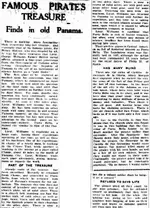
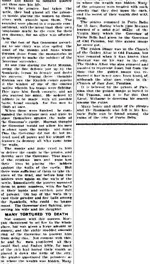
Kanacki
You can see more of the story in the Canberra Times 17th of February 1927. Tells more below.


Kanacki
Colombiapictures
Hero Member
Great stories. Please tell us more.
You have a fantastic treasure in your archives.
You have a fantastic treasure in your archives.
KANACKI
Bronze Member
- Joined
- Mar 1, 2015
- Messages
- 1,445
- Reaction score
- 5,940
- Golden Thread
- 0
- Primary Interest:
- All Treasure Hunting
Pirate's Buried Treasure theme really took hold late 19th century through most of early 20th to mid 20th century. Many such yarns and claims came up. There has be a few people claiming to be related to Captain Morgan through the 20th century. Even other supposed treasure legends attributed to Captain Morgan hiding treasure. One such story is from Australian town and country journal dated 16th November 1895. No one claiming Morgan ancestry but buried treasure from one of Morgans ships as he fled Porto Bello after the 1671 raid on Panama.
Santa Catalina, and has probably been responsible for more expeditions than than others. Santa Catalina is a little point sand and rock rising out of the Caribbean Sea, ninety miles off the Mosquito Coast of Central America. It is about a mile in circumference, and contains a network of caverns.
Morgan was the most successful of the buccaneers that preyed upon the Spaniards in America, and his raid upon Panama in 1670-71 was his greatest enterprise. According" to the legend, one shipload of its plunder was lost by Morgan. The crew of one. vessel took the precaution of running away with the treasure, with which it was laden, in order to prevent Morgan from indulging in the practice referred to.
Morgan captured them subsequently, but not until they had disposed of their spoils, and they died under torture rather than reveal
the hiding place. For a couple of centuries legendary stories have been current that the treasures were buried on Santa Catalina.
Two men are reputed to have found treasures on Santa'Catalina in the, last twenty years; One may be dismissed briefly. He is described as Alexander Archibald, of Old Providence, an island of the same group, and he is said to have discovered a jar containing £5000 while digging a. well.
The story has simply never been verified; nor has .the existence of Mr. Archibald been demonstrated. There is a good deal to be said about the other man, John Currie, trader, of Kingston, Jamaica. He landed upon the island from a Spanish vessel one day in search of wood .and water. . . While there he came across an iguana and chased it. . The animal ran into a hole. He put his hand into the hole, and felt some masonry, and discovered the walled-up entrance to a cavern.
Making his way in, this was the glorious sight he beheld-nine earthen jars as tail as a man filled to the brim with Spanish doubloon; cases filled with jewels, and gold ware and silverware strewn about. Wishing to conceal the existence of the treasure from the Spaniards on the vessel, he contented himself with taking about £2000 in gold and some jewellery. Then he replaced the masonry and sailed away. Currie, went back to Kingston.
And there the late Eari of Lonsdale came upon the scene. , In the winter of 1879-80, while cruising In his yacht in the West Indies,' he heard about Currie, looked him up, and got him to tell about the discovery. . Currie exhibited as proofs that his story was true some ancient Spanish doubloons and some very curious ornaments so with diamonds in an antique fashion.
The Earl was soon convinced, and an 'agreement ' was entered Into between the two by which Lonsdale was to contribute his yacht for the purpose of án expédition, ; and Currie was to disclose the opening to the cavern.
At the last moment Currie brought the projected expedition to a stand still by,disappearing. A. tragedy followed this fiasco. Currie had exhibited his Spanish doubloons and diamond ornaments to Mr. Compton, the British Consul at Colon. Mr. Compton, like others, was finally convinced of the truth of the story, and risked his whole fortune in a new expedition in search of the treasure at Santa Catalina. To guard against interference, on the part of the natives, Mr., Compton secured through the influence of his'friends the services of a British man-of-war to act as convoy. ' Currie could not avoid accompanying this expedition, hut, like the others, it was a failure. After reaching the island Currie announced that he had decided to refuse to show where the treasure.was hidden, because he was afraid that in the division he would not receive a fair share.
Threats and promises alike proved useless to make him alter his determination.- Then they sailed away, and Mr. Compton blew out his
brains in despair.
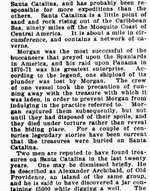
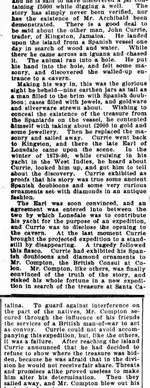
Henry Morgan was so famous nearly every mosquito bitten rat hole in Caribbean wanted to claim to be the hiding place of Morgans lost treasure. There are stories of Morgans treasure hid in Porto Bello, Panama Providence, St Catherine's island, Cayman island, along chargres River, Roatan Honduras and even in the hills of Jamaica itself.
So when some one claims such things I tend to be weary of such claims. I have other stories of Morgans alleged hidden treasure. But once again old Kanacki need his grandpa nap.
Kanacki
Santa Catalina, and has probably been responsible for more expeditions than than others. Santa Catalina is a little point sand and rock rising out of the Caribbean Sea, ninety miles off the Mosquito Coast of Central America. It is about a mile in circumference, and contains a network of caverns.
Morgan was the most successful of the buccaneers that preyed upon the Spaniards in America, and his raid upon Panama in 1670-71 was his greatest enterprise. According" to the legend, one shipload of its plunder was lost by Morgan. The crew of one. vessel took the precaution of running away with the treasure, with which it was laden, in order to prevent Morgan from indulging in the practice referred to.
Morgan captured them subsequently, but not until they had disposed of their spoils, and they died under torture rather than reveal
the hiding place. For a couple of centuries legendary stories have been current that the treasures were buried on Santa Catalina.
Two men are reputed to have found treasures on Santa'Catalina in the, last twenty years; One may be dismissed briefly. He is described as Alexander Archibald, of Old Providence, an island of the same group, and he is said to have discovered a jar containing £5000 while digging a. well.
The story has simply never been verified; nor has .the existence of Mr. Archibald been demonstrated. There is a good deal to be said about the other man, John Currie, trader, of Kingston, Jamaica. He landed upon the island from a Spanish vessel one day in search of wood .and water. . . While there he came across an iguana and chased it. . The animal ran into a hole. He put his hand into the hole, and felt some masonry, and discovered the walled-up entrance to a cavern.
Making his way in, this was the glorious sight he beheld-nine earthen jars as tail as a man filled to the brim with Spanish doubloon; cases filled with jewels, and gold ware and silverware strewn about. Wishing to conceal the existence of the treasure from the Spaniards on the vessel, he contented himself with taking about £2000 in gold and some jewellery. Then he replaced the masonry and sailed away. Currie, went back to Kingston.
And there the late Eari of Lonsdale came upon the scene. , In the winter of 1879-80, while cruising In his yacht in the West Indies,' he heard about Currie, looked him up, and got him to tell about the discovery. . Currie exhibited as proofs that his story was true some ancient Spanish doubloons and some very curious ornaments so with diamonds in an antique fashion.
The Earl was soon convinced, and an 'agreement ' was entered Into between the two by which Lonsdale was to contribute his yacht for the purpose of án expédition, ; and Currie was to disclose the opening to the cavern.
At the last moment Currie brought the projected expedition to a stand still by,disappearing. A. tragedy followed this fiasco. Currie had exhibited his Spanish doubloons and diamond ornaments to Mr. Compton, the British Consul at Colon. Mr. Compton, like others, was finally convinced of the truth of the story, and risked his whole fortune in a new expedition in search of the treasure at Santa Catalina. To guard against interference, on the part of the natives, Mr., Compton secured through the influence of his'friends the services of a British man-of-war to act as convoy. ' Currie could not avoid accompanying this expedition, hut, like the others, it was a failure. After reaching the island Currie announced that he had decided to refuse to show where the treasure.was hidden, because he was afraid that in the division he would not receive a fair share.
Threats and promises alike proved useless to make him alter his determination.- Then they sailed away, and Mr. Compton blew out his
brains in despair.


Henry Morgan was so famous nearly every mosquito bitten rat hole in Caribbean wanted to claim to be the hiding place of Morgans lost treasure. There are stories of Morgans treasure hid in Porto Bello, Panama Providence, St Catherine's island, Cayman island, along chargres River, Roatan Honduras and even in the hills of Jamaica itself.
So when some one claims such things I tend to be weary of such claims. I have other stories of Morgans alleged hidden treasure. But once again old Kanacki need his grandpa nap.
Kanacki
Colombiapictures
Hero Member
Legends.
They say that within every legend there is a grain of truth.
They say that within every legend there is a grain of truth.
Professor of Engineering
Ruby Member
- Joined
- Oct 5, 2014
- Messages
- 31,886
- Reaction score
- 35,434
- Golden Thread
- 1
- Location
- Massachusetts
- 🥇 Banner finds
- 1
- 🏆 Honorable Mentions:
- 1
- Detector(s) used
- Garrett: AT Pro, AT Gold & Infinium; Minelab: Explorer SE, II; Simplex; Tesoro: Tejon & Outlaw; White's: V3i
- Primary Interest:
- Relic Hunting
Good luck on your research and search! 
Colombiapictures
Hero Member
A grain of truth on a beach of fantasy.
Obviously this is not the way to search for treasure.
If we want to search for treasure, we must first try to verify the facts.
But what are facts?
Even if we have 5 eye witnesses reporting an event, each of the accounts will be different from the others.
The accounts are subjective.
Each individual sees and hears and feels things with his own senses. As an example, The loss of an eye or an ear might have been quite common in the pirate world.
Or, Exquemelin might have had a grudge against Henry Morgan and "see" things from a different angle because of that.
If we are lucky, we may find some coincidences.
Many coincidences confirming a fact, is probably the best we can hope for.
Then we need to use common sense, like: you are running away from an army of angry Spaniards, with 100 pounds of plundered silver plates and candlesticks on your back. How long will you hold on to the silver? At what point will you just dump it and run for your life?
Obviously this is not the way to search for treasure.
If we want to search for treasure, we must first try to verify the facts.
But what are facts?
Even if we have 5 eye witnesses reporting an event, each of the accounts will be different from the others.
The accounts are subjective.
Each individual sees and hears and feels things with his own senses. As an example, The loss of an eye or an ear might have been quite common in the pirate world.
Or, Exquemelin might have had a grudge against Henry Morgan and "see" things from a different angle because of that.
If we are lucky, we may find some coincidences.
Many coincidences confirming a fact, is probably the best we can hope for.
Then we need to use common sense, like: you are running away from an army of angry Spaniards, with 100 pounds of plundered silver plates and candlesticks on your back. How long will you hold on to the silver? At what point will you just dump it and run for your life?
Colombiapictures
Hero Member
perdidogringo
Sr. Member
Interesting Thread
It's good to see some attention given to Panama! I've detected all over Panama and have had a bit of success finding some goodies. I, personally, don't believe Morgan left any wealth anywhere. He had no reason to as after sacking (what is now called) Old Panama he eventually drank himself to death as a governor of and a land owner in Jamaica. He would have had plenty of time and opportunity to return to Panama or anywhere else for any "buried treasure." Especially when he exerted so much effort to acquire the wealth to begin with.
The only documented treasure ever buried on purpose in Panama (that I know of) was Sir Francis Drake's hastily buried treasure south of Nombre de Dios after he robbed the mule train in 1573. And Drake certainly didn't want to bury anything. He was forced to as it was more treasure than he could carry away with the Spanish reinforcements quickly closing in. And the Spanish (and a couple weeks later some of Drake's men who returned to the scene) came back and easily dug up the vast majority of it. I still think the odd silver bar is there and have searched the area several times. However, anything left has sunk far too deep in a tropical environment, far beyond the reach of most standard metal detectors.
It's good to see some attention given to Panama! I've detected all over Panama and have had a bit of success finding some goodies. I, personally, don't believe Morgan left any wealth anywhere. He had no reason to as after sacking (what is now called) Old Panama he eventually drank himself to death as a governor of and a land owner in Jamaica. He would have had plenty of time and opportunity to return to Panama or anywhere else for any "buried treasure." Especially when he exerted so much effort to acquire the wealth to begin with.
The only documented treasure ever buried on purpose in Panama (that I know of) was Sir Francis Drake's hastily buried treasure south of Nombre de Dios after he robbed the mule train in 1573. And Drake certainly didn't want to bury anything. He was forced to as it was more treasure than he could carry away with the Spanish reinforcements quickly closing in. And the Spanish (and a couple weeks later some of Drake's men who returned to the scene) came back and easily dug up the vast majority of it. I still think the odd silver bar is there and have searched the area several times. However, anything left has sunk far too deep in a tropical environment, far beyond the reach of most standard metal detectors.
KANACKI
Bronze Member
- Joined
- Mar 1, 2015
- Messages
- 1,445
- Reaction score
- 5,940
- Golden Thread
- 0
- Primary Interest:
- All Treasure Hunting
In the following newspaper Hobart Mercury dated Wed 30TH of January 1924. Bernard Joacum Keegan a Diver and Second Mate of the American Salvage tug Favorite. During a salvage work found out from locals about a legendary sea cave on Providence island made a dive to search for Henry Morgans alleged treasure.
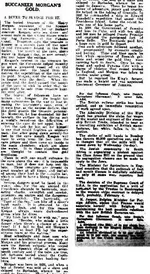
No doubt the locals was influenced by the earlier 1880 treasure hunt that ended in failure.
Kanacki

No doubt the locals was influenced by the earlier 1880 treasure hunt that ended in failure.
Kanacki
KANACKI
Bronze Member
- Joined
- Mar 1, 2015
- Messages
- 1,445
- Reaction score
- 5,940
- Golden Thread
- 0
- Primary Interest:
- All Treasure Hunting
Could the initials HM on this 17th century plate mean it belonged to Henry Morgan?
View attachment 1731637
Hello Columbia pictures.
Sadly not Henry Morgan was not the owner. If you look at the HM it means his Majesty. The mint mark on the left is the mark of Charles the Second King of England And the Other Mint mark on the right is from the London Mint. While its not impossible the silver itself before being melted down came via Morgans invasion of Panama? But nothing is certain and almost impossible verify the origins other than originated from Bolivia Peru?
Charles II (29 May 1630 – 6 February 1685) was king of England, Scotland, and Ireland. He was king of Scotland from 1649 until his deposition in 1651, and king of England, Scotland and Ireland from the restoration of the monarchy in 1660 until his death.
It should be noted all silver from Charles II time period in England is referred to Charles II silverware even if he did not actually own it. However picture you posted and Charles II mint mark and HR point to the item actually belonging to Charles the II.
Kanacki
Last edited:
KANACKI
Bronze Member
- Joined
- Mar 1, 2015
- Messages
- 1,445
- Reaction score
- 5,940
- Golden Thread
- 0
- Primary Interest:
- All Treasure Hunting
Hello ColumbiaPictures
My apologies I have lead you astray. After blowing up the picture.
1. The mark on the right of the picture gives the place of manufacture It definitely London Tower Mint mark Crown sitting on top of a Tudor Rose on the right that was used between 1562 and 1578. You can see the word on London on top of the Crown and English Tudor rose. The London mark date from the time of Henry VIII. That could indicate the silver came via Francis Drake : 1563–1596? But definitely not related Henry Morgans time. . By 1600, Porto Bello had replaced Nombre de Dios (where Sir Francis Drake had first attacked a Spanish settlement) as the Isthmus of Panama's Caribbean port for the Spanish Silver Train and the annual treasure fleet.
2, H M letters is the initials of the silver smith the craftsman of the piece.
There should be a single letter inside a square stamped somewhere but not in the picture? It is stamped in cycles of twenty letters of the alphabet of different shape identifies the year in which the piece was verified by the Assay Office.
Spanish ships had brought goods from the New World since Christopher Columbus's first expedition of 1492. The organized system of convoys dates from 1564, but Spain sought to protect shipping prior to that by organizing protection around the largest Caribbean island, Cuba and the maritime region of southern Spain and the Canary Islands because of attacks by pirates and foreign navies. The Spanish government created a system of convoys in the 1560s in response to the sacking of Havana by French privateers.
3. On the left side mark is a bit of a mystery? After the trauma of the English civil war much silver plate was lost stolen traded from original owners. Charles II returned from exile and was made king after the Republican commonwealth failed and brought in the restoration period of the monarchy began. Charles came back virtually broke and acquired silver recovered from lost estates such as his ancestor Henry VIII As far as I tell it has Charles on the bottom but hard to see because of heavy wear? However the name on closer examination does it not appear Charles II? Charles who belonged to the house of Stuart stamp mark on the left of the picture is not his crest. Its is possibly the mark of the maker ie silver smith. However Charles II official mint mark used from 1660-1662 was a crown used in the London mint.
The origin of the silver was most likely from Scotland considering the earliest date of London marks. However it could still be possible that the silver was captured from the Spanish by Drake also before his world cruise on the golden hind?While it is true some of the more wealthy families had crests stamped onto their silver ware because silver back then was really a precious metal. But later generations as more silver became available did not seek the need to label their own silver.
Duty marks did not come into practice until 1794
Note there should be marking of lion some where on the plate to conform to the standard purity. i should also state each town mint marks used their own stamped Date letters for example varied between each town mints. For example H would of been used 1545-46 in the London Mint. Glasgow Sheffield or Dublin etc would used their own different letter for the same date.
I hope that gives you some more clarification.
Kanacki
My apologies I have lead you astray. After blowing up the picture.
1. The mark on the right of the picture gives the place of manufacture It definitely London Tower Mint mark Crown sitting on top of a Tudor Rose on the right that was used between 1562 and 1578. You can see the word on London on top of the Crown and English Tudor rose. The London mark date from the time of Henry VIII. That could indicate the silver came via Francis Drake : 1563–1596? But definitely not related Henry Morgans time. . By 1600, Porto Bello had replaced Nombre de Dios (where Sir Francis Drake had first attacked a Spanish settlement) as the Isthmus of Panama's Caribbean port for the Spanish Silver Train and the annual treasure fleet.
2, H M letters is the initials of the silver smith the craftsman of the piece.
There should be a single letter inside a square stamped somewhere but not in the picture? It is stamped in cycles of twenty letters of the alphabet of different shape identifies the year in which the piece was verified by the Assay Office.
Spanish ships had brought goods from the New World since Christopher Columbus's first expedition of 1492. The organized system of convoys dates from 1564, but Spain sought to protect shipping prior to that by organizing protection around the largest Caribbean island, Cuba and the maritime region of southern Spain and the Canary Islands because of attacks by pirates and foreign navies. The Spanish government created a system of convoys in the 1560s in response to the sacking of Havana by French privateers.
3. On the left side mark is a bit of a mystery? After the trauma of the English civil war much silver plate was lost stolen traded from original owners. Charles II returned from exile and was made king after the Republican commonwealth failed and brought in the restoration period of the monarchy began. Charles came back virtually broke and acquired silver recovered from lost estates such as his ancestor Henry VIII As far as I tell it has Charles on the bottom but hard to see because of heavy wear? However the name on closer examination does it not appear Charles II? Charles who belonged to the house of Stuart stamp mark on the left of the picture is not his crest. Its is possibly the mark of the maker ie silver smith. However Charles II official mint mark used from 1660-1662 was a crown used in the London mint.
The origin of the silver was most likely from Scotland considering the earliest date of London marks. However it could still be possible that the silver was captured from the Spanish by Drake also before his world cruise on the golden hind?While it is true some of the more wealthy families had crests stamped onto their silver ware because silver back then was really a precious metal. But later generations as more silver became available did not seek the need to label their own silver.
Duty marks did not come into practice until 1794
Note there should be marking of lion some where on the plate to conform to the standard purity. i should also state each town mint marks used their own stamped Date letters for example varied between each town mints. For example H would of been used 1545-46 in the London Mint. Glasgow Sheffield or Dublin etc would used their own different letter for the same date.
I hope that gives you some more clarification.
Kanacki
Last edited:
Similar threads
- Replies
- 2
- Views
- 776
- Replies
- 17
- Views
- 394
- Replies
- 46
- Views
- 5K
Users who are viewing this thread
Total: 1 (members: 0, guests: 1)



